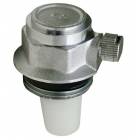Materials used to produce air vent valves
The brass used for the production of air vent valves contain alloy elements necessary for the correction function of the components.

One of the requirements noticed in the systems that use air as a flux is the need to evacuate the excess load of air to guarantee the flow within the primary work circuits. This is the main aim of air vent valves.
The opening mechanism of the valve is guaranteed by the stainless steel spring, that together with the pressure applied on the plug, is capable of opening or closing itself in order to expell the quantity of air necessary to return to the correct nominal value.
The elements used for the construction of Gnali Bocia’s air vent valves form a metal alloy known as brass, as well as copper and zinc there are also metal, nickel, tin and lead. The importance of specific alloy elements in the correct percentages is fundamental to obtain an alloy with the necessary physical and resistance properties.
Break resisitance goes from 380 to 430 Mpa and the unit yield points are in reference to those of breakage, 160 and 250 Mpa.
Other interesting facts can be the lengthening: 18% for brass with extensibilty of 380 Mpa and 10% for those at 340 Mpa.
A fundamental aspect regards the setting of maximum working temperature that settle at 100° and the maximum working pressure which can reach 10 bar.
These characteristics make the air vent valves suitable for their designated use.
The opening mechanism of the valve is guaranteed by the stainless steel spring, that together with the pressure applied on the plug, is capable of opening or closing itself in order to expell the quantity of air necessary to return to the correct nominal value.
The elements used for the construction of Gnali Bocia’s air vent valves form a metal alloy known as brass, as well as copper and zinc there are also metal, nickel, tin and lead. The importance of specific alloy elements in the correct percentages is fundamental to obtain an alloy with the necessary physical and resistance properties.
Break resisitance goes from 380 to 430 Mpa and the unit yield points are in reference to those of breakage, 160 and 250 Mpa.
Other interesting facts can be the lengthening: 18% for brass with extensibilty of 380 Mpa and 10% for those at 340 Mpa.
A fundamental aspect regards the setting of maximum working temperature that settle at 100° and the maximum working pressure which can reach 10 bar.
These characteristics make the air vent valves suitable for their designated use.
02/10/2013
I contenuti di questo sito non hanno carattere di periodicità e non rappresentano 'prodotto editoriale'.








